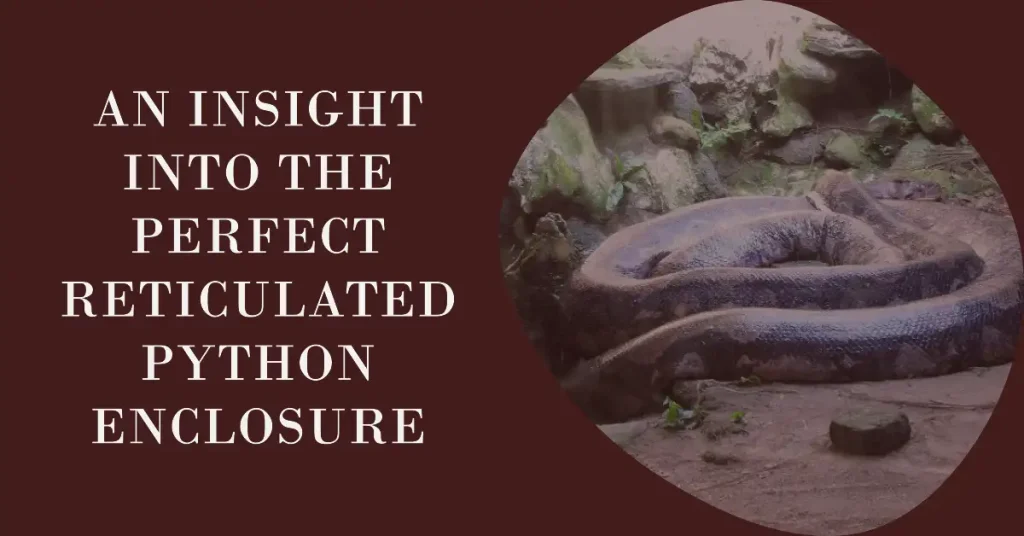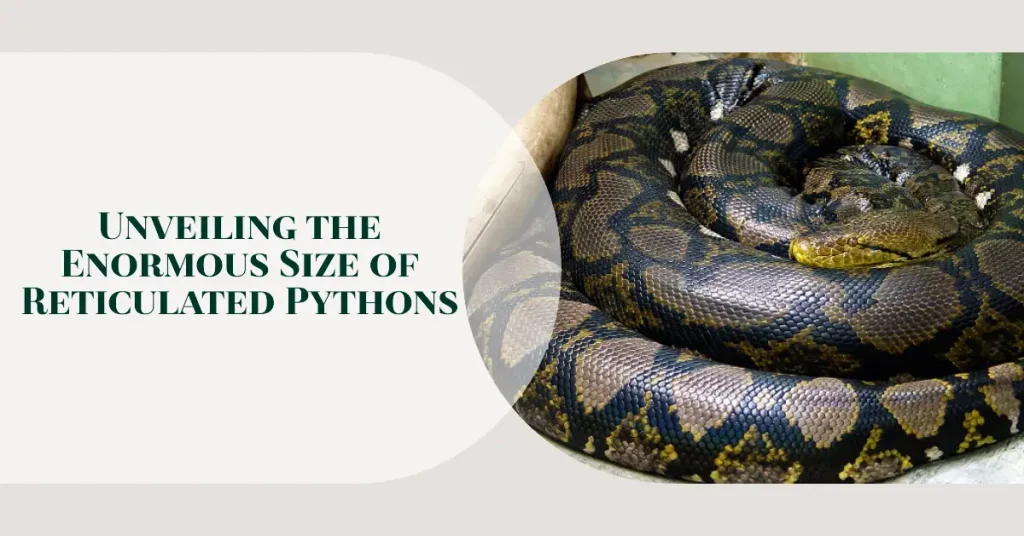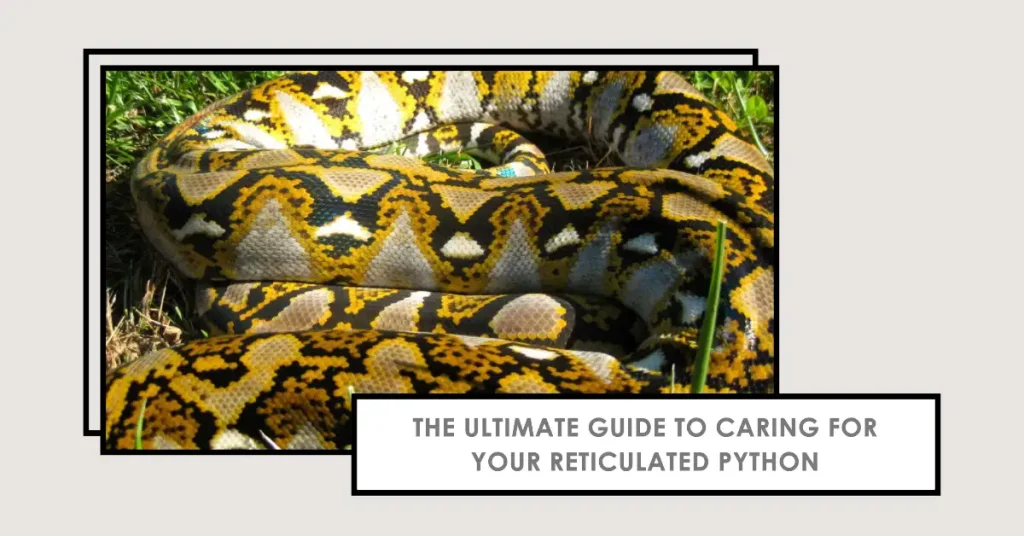As a reticulated python owner myself, I understand the importance of providing the best possible enclosure for these beautiful reptiles. A poorly designed and maintained enclosure can lead to health issues, stress, and even escape attempts. In this ultimate guide, I will share my knowledge and experience on how to create an optimal reticulated python enclosure.
Key Takeaways:
- Creating a suitable enclosure is crucial for the health and wellbeing of reticulated pythons.
Understanding Reticulated Pythons
It is essential to understand the animal you are writing about. Reticulated pythons are fascinating creatures that require specific care and attention to thrive in captivity. In this section, I will explore the key aspects of reticulated python care that are relevant to creating their enclosure.
Native to Southeast Asia, reticulated pythons are the longest snake species in the world, with adults reaching up to 20 feet in length. In the wild, they inhabit a range of environments, including rainforests, grasslands, and swamps. As such, they require a large, secure enclosure that mimics their natural habitat and provides ample space for movement and exploration.
Behavior
Reticulated pythons are diurnal creatures, meaning they are active during the day and rest at night. They are considered ambush predators, using their impressive size and strength to overpower prey, such as rodents and small mammals. As they age, they may become more aggressive and territorial, so it is important to handle them with care and respect.
Size
The size of a reticulated python enclosure is a crucial factor to consider. Juvenile pythons can thrive in a 20-gallon tank or similar-sized enclosure, while adults require a much larger space, ranging from 100 to 200 gallons or more. Proper space allows for natural movements and reduces stress, leading to a healthier and happier python.
It is important to note that reticulated pythons grow quickly. Therefore, it is essential to plan for their future size when choosing and setting up an enclosure.
Specific Needs
When creating an enclosure for a reticulated python, it is vital to consider their specific needs. Temperature and humidity are crucial factors to regulate to ensure the snake’s health and well-being. The enclosure should include a basking spot with a temperature range of 88°F to 90°F and a cooler zone with a temperature range of 78°F to 80°F. Humidity levels should be kept between 50% and 60%, with a higher range of 70% to 80% during shedding.
Reticulated pythons require a variety of hiding spots and climbing opportunities, such as branches and rocks, within their enclosure to simulate their natural environment. A substrate material such as cypress mulch or coconut husk can help maintain proper humidity levels and provide a comfortable surface for the snake to rest on.
By understanding these key aspects of reticulated python care, you can create an optimal environment that promotes optimal health and well-being for your pet.
Choosing the Right Enclosure
When it comes to selecting an enclosure for your reticulated python, there are several factors to consider. These include the type of enclosure, size, material, ventilation, and security. The right enclosure will provide your python with a comfortable and safe environment to thrive in.
Type of Enclosure
There are several types of enclosures available, such as tanks, cages, and terrariums. Tanks are typically made of glass or acrylic, while cages are often made of metal or PVC. Terrariums are usually made of glass and offer a more naturalistic look. Each type has its own advantages and disadvantages.
Enclosure Size
The size of your python enclosure will depend on the age and expected growth of your python. A young python will require a smaller enclosure, while a full-grown python will need a larger one. As a general rule, the enclosure should be at least as long as the python, with enough width and height to allow for movement and climbing.
Enclosure Material
The material of the enclosure is crucial for maintaining the proper temperatures and humidity levels. Glass enclosures tend to hold heat better, while mesh or screen enclosures provide better ventilation. PVC enclosures are lightweight and easy to clean, while wooden enclosures offer a more natural look. Each material has its own advantages and disadvantages.
Ventilation and Security
Proper ventilation is essential for maintaining a healthy environment for your python. The enclosure should have enough ventilation to allow for proper air circulation and prevent the buildup of harmful gases. Additionally, the enclosure should be escape-proof and have secure locks to prevent your python from escaping or being accessed by unauthorized persons.
By considering these factors when choosing the right enclosure for your reticulated python, you can create a safe and comfortable habitat for your pet to thrive in.
Enclosure Size and Setup
The size and setup of a reticulated python enclosure is crucial for the health and wellbeing of your pet. As pythons can grow to be quite large, it’s important to provide an enclosure that is appropriate for their size and allows for adequate exercise and exploration.
The general rule of thumb for enclosure size is to provide a space that is at least as long as the python and twice as wide as the python’s width. For a juvenile python, a 40-gallon tank can work, but as they grow, a larger enclosure will be necessary. An adult reticulated python requires an enclosure that is at least 8 feet long, 4 feet wide, and 3 feet high.
When setting up the enclosure, be sure to include plenty of hiding spots, climbing opportunities, and substrate to allow for natural behaviors. A substrate of cypress mulch or coconut husk is ideal, as it can retain moisture and aid in maintaining proper humidity levels. Provide multiple hiding spots, such as rocks, logs, and branches, and create a basking area with a heat lamp to keep the enclosure at the correct temperature.
It’s also important to ensure that the enclosure is secure and escape-proof. Cover ventilation areas with mesh screens and use locks on all doors to prevent the python from escaping. Avoid using materials that are sharp or could cause harm to the python, such as metal or rough wood.
Heating and Lighting
Creating a proper temperature gradient within the reticulated python enclosure is crucial for the snake’s health and well-being. Pythons are cold-blooded creatures and rely on external heat sources to regulate their body temperature. Therefore, it’s essential to provide a range of temperatures within the enclosure, so the python can move to the most comfortable spot.
I recommend using a combination of heating methods to create a temperature gradient. A heat mat can be placed under one side of the enclosure to create a warmer area, while a basking lamp can be used to provide a heat source on the other side. It’s important to monitor the temperature regularly with a thermometer to ensure it stays within the suitable range. For reticulated pythons, the ideal daytime temperature should be between 85-90°F (29-32°C) on the warm side, and 75-80°F (24-27°C) on the cooler side.
Lighting is also an essential aspect of a reticulated python enclosure. While these snakes don’t require UVB lighting like some reptiles, providing a lighting source that mimics their natural environment can be beneficial. A regular light bulb or a reptile-specific heat lamp can be used for this purpose. It’s recommended to provide a 12-hour light-dark cycle, which can be adjusted to reflect the natural daylight hours in your area.
Remember to avoid using heat rocks or other heating elements that the python can come into direct contact with, as they can burn or injure the snake.
Substrate Options
Choosing the right substrate is crucial for creating a comfortable and healthy environment for your reticulated python. There are several options available, each with their own advantages and disadvantages.
Newspaper
Newspaper is a cheap and readily available option that is easy to clean and replace. However, it does not provide any naturalistic or stimulating environment for your python.
Cypress mulch
Cypress mulch is another popular option that provides a naturalistic appearance and helps retain humidity in the enclosure. However, it can be dusty and may cause respiratory issues for your python if not maintained properly.
Coconut husk
Coconut husk, also known as coco coir, is a natural and biodegradable option that retains moisture well and helps prevent odors. However, it can be difficult to clean and tends to mold easily if not replaced regularly.
Aspen bedding
Aspen bedding is a popular choice for its ease of cleaning and low dust content. It also provides a naturalistic appearance and absorbs moisture well. However, it can be expensive and may not retain humidity as well as other options.
Ultimately, the choice of substrate depends on your personal preference and the needs of your reticulated python. It is important to replace the substrate regularly and maintain proper hygiene to prevent any potential health risks.
Furnishing the Enclosure
Designing and furnishing your reticulated python’s enclosure can be a fun and creative process while also providing a stimulating and visually pleasing environment for your pet. Here are some tips and ideas:
Decorations
When selecting decorations for the enclosure, make sure they are safe for your python to interact with. Avoid anything sharp or potentially toxic. Large, sturdy decorations such as logs, rocks, and branches can provide climbing opportunities and places to hide. Artificial plants or live plants that are safe for reptiles can add a natural feel to the enclosure.
Substrate
The substrate you choose not only affects the aesthetic of the enclosure but also plays a crucial role in your python’s health and hygiene. Consider using a combination of substrates, such as cypress mulch and coconut husk, to provide a comfortable and absorbent base. You can also add a layer of sphagnum moss or similar material to help maintain humidity and provide a soft surface for your python to burrow in.
Enrichment
Regular enrichment is important for your python’s mental and physical wellbeing. Consider adding new decorations or rearranging existing ones to keep the enclosure interesting. Additionally, providing prey items for your python to hunt and eat can be an enriching activity.
Temperature and Lighting
Make sure to maintain the appropriate temperature gradient in the enclosure for your python’s health and comfort. You can also use lighting to mimic the day-night cycle, which can help regulate your python’s behavior and promote a healthy feeding schedule. UVB lighting can also be used to provide additional benefits to your python’s health.
Safe Introductions
When adding new decorations or plants to the enclosure, make sure to clean them thoroughly and ensure they are safe for your python to interact with. Introduce new elements gradually to avoid overwhelming your python and allow them to adjust to any changes in their environment.
Feeding and Watering
Feeding and watering are crucial aspects of reticulated python care, and it’s essential to provide your pet with a well-balanced diet and clean water at all times.
Diet: Reticulated pythons are carnivorous and require a diet of appropriately sized prey. Young pythons should be fed small rodents, while adult pythons can be given larger prey such as rabbits or pigs. It’s important to feed your python pre-killed prey to avoid the risk of injury to both the python and the feeder. Additionally, it’s essential to maintain a feeding schedule that is appropriate for your python’s age and size. Adult pythons typically need to be fed once every two to four weeks, while younger pythons may require more frequent feeding.
Feeding Area: It’s best to have a separate feeding area for your python to avoid any substrate ingestion or accidental bites. A feeding box or a separate enclosure can serve as an appropriate feeding area, and it should be kept clean and disinfected after each feeding.
Water: Reticulated pythons require clean, fresh water at all times for hydration. A large, heavy water dish should be provided in the enclosure, and it should be cleaned and refilled regularly. Make sure to use a water dish that is sturdy and won’t tip over, as pythons may occasionally soak in their water dish.
Supplements: In some cases, vitamin and mineral supplements may be necessary to ensure your python is getting all the necessary nutrients. However, it’s best to consult with a veterinarian or a reptile specialist before introducing any supplements to your python’s diet.
Maintenance and Cleaning
Proper maintenance and cleaning of your reticulated python enclosure is crucial for the health and well-being of your pet. Here are some tips to keep your snake’s habitat clean and safe:
- Spot clean the enclosure as needed, removing any feces or uneaten food immediately.
- Replace the substrate on a regular basis, depending on the material used and the size of your python.
- Sanitize the enclosure regularly to prevent bacteria and mold growth. Use a reptile-safe disinfectant and rinse thoroughly with clean water.
- Check all equipment regularly, including heating and lighting sources, for any damage or malfunction.
It is also a good idea to wear gloves and wash your hands thoroughly before and after handling your python or cleaning their enclosure. This will prevent the transfer of bacteria or parasites between you and your pet.
“Remember, a clean and well-maintained enclosure is a healthy home for your reticulated python.”
Safety Measures
When it comes to reticulated python enclosures, safety should always be a top priority. Here are some safety measures to keep in mind:
- Ensure the enclosure has secure locks to prevent the python from escaping.
- Avoid using sharp or pointed objects in the enclosure that may harm the python.
- Choose safe plants and decorations to avoid potential toxicity or ingestion hazards.
- Keep the enclosure away from potential dangers such as electrical cords or chemicals.
- Handle the python with care and always have a second person present for safety.
Remember to regularly check the enclosure for any potential safety risks and make adjustments as necessary. By taking these safety measures, you can help prevent any harm to both your reticulated python and yourself.
Common Mistakes to Avoid
I have seen many new reticulated python owners make some common mistakes. These mistakes can be easily avoided by following the guidelines mentioned in the previous sections. Here are some of the most typical mistakes to watch out for:
- Choosing the wrong sized enclosure: Be sure to select the enclosure that is appropriate for the size of your python. A small enclosure can lead to stress, while an excessively large enclosure can cause difficulty in maintaining the right temperature and humidity levels.
- Neglecting temperature and humidity: Reticulated pythons require a warm and humid environment to thrive. Neglecting temperature and humidity levels can lead to health issues such as respiratory infections.
- Using the wrong substrate: Some substrates can be harmful to reticulated pythons. Be sure to do research when selecting a substrate for your enclosure to avoid any potential health risks.
- Excessive handling: Reticulated pythons are not social animals and do not require frequent handling. Handling them too often can cause stress and anxiety, leading to unwanted behavior.
- Ignoring feeding and watering: Providing your python with improper nutrition and hydration can lead to health problems. Be sure to offer fresh water at all times and provide a balanced diet for your python.
- Neglecting maintenance and cleaning: Failing to maintain a clean and hygienic enclosure can lead to health risks for both you and your pet. Regular cleaning and maintenance are essential.
- Ignoring safety measures: A secure and escape-proof enclosure is crucial to prevent accidents and injuries. Be sure to follow recommended safety guidelines to keep your python and yourself safe.
By avoiding these common mistakes and following the guidelines provided in this article, you can create the perfect reticulated python enclosure for your pet.
Conclusion
Creating an ideal reticulated python enclosure can be a challenging task for any pet owner. However, with proper research and planning, it can also be a rewarding experience that provides a comfortable and stimulating habitat for your pet python.
In this guide, I covered the essential aspects of reticulated python care and enclosure setup, including the appropriate enclosure size, heating and lighting, substrate options, and furnishing. I also provided guidance on feeding, watering, maintenance, safety measures, and common mistakes to avoid.
Remember, your reticulated python enclosure is not just a place for your pet to live, but also an environment that can affect their overall health and well-being. It is crucial to provide a safe, clean, and enriching space that mimics their natural habitat and meets their specific needs.
By following the tips and advice in this guide, you can create the ultimate reticulated python enclosure that your pet will call home for years to come. Take the time to research and plan, and don’t hesitate to ask for help or advice from experienced pet owners or professionals in the field.
FAQ
Q: What is the importance of creating the perfect enclosure for reticulated pythons?
A: Creating the perfect enclosure for reticulated pythons is crucial for their health, well-being, and overall quality of life. It provides them with a safe and comfortable environment that mimics their natural habitat, allowing them to thrive and exhibit natural behaviors.
Q: What are the key aspects of reticulated python care that are relevant to creating their enclosure?
A: Understanding the natural habitat, behavior, size, and specific needs of reticulated pythons is essential when creating their enclosure. This knowledge helps ensure that the enclosure adequately meets their requirements and promotes their overall health and happiness.
Q: What are the different types of enclosures that can be used for reticulated pythons?
A: There are various types of enclosures that can be used for reticulated pythons, including tanks, cages, and terrariums. Each option has its own advantages and disadvantages, and the choice depends on factors such as the snake’s size, space availability, and personal preference.
Q: What features should be considered when choosing an enclosure for reticulated pythons?
A: When selecting an enclosure for reticulated pythons, important features to consider include size, material, ventilation, and security. The enclosure should be spacious enough for the snake to move around comfortably, made of appropriate materials that are easy to clean and maintain, well-ventilated to ensure proper airflow, and securely lockable to prevent escape.
Q: How do I determine the appropriate enclosure size and setup for my reticulated python?
A: The enclosure size for a reticulated python depends on its age and expected growth. It should be large enough for the snake to stretch out fully and have ample room for movement. Additionally, the setup should include appropriate substrate, hiding spots, climbing opportunities, and proper temperature and humidity control to create a comfortable and stimulating environment for the snake.
Q: What heating and lighting requirements should be met in a reticulated python enclosure?
A: In a reticulated python enclosure, it is crucial to provide a proper temperature gradient, mimicking their natural environment. Different heating methods, such as heating pads or overhead heat lamps, can be used to achieve this. Additionally, appropriate lighting options, such as UVB bulbs, may be required to meet the snake’s lighting needs.
Q: What substrate options are suitable for reticulated python enclosures?
A: There are several substrate choices for reticulated python enclosures, including newspaper, cypress mulch, coconut husk, and aspen bedding. The selection depends on factors such as absorbency, ease of cleaning, and the snake’s specific needs. It is important to maintain cleanliness and hygiene within the enclosure to prevent potential health issues.
Q: How can I create a visually appealing and enriching habitat within the reticulated python enclosure?
A: The design and furnishing of a reticulated python enclosure can be enhanced by selecting appropriate decorations, branches, rocks, and plants. These elements provide hiding spots and climbing opportunities, making the enclosure visually appealing and engaging for the snake. Regular enrichment and the safe introduction of new elements further stimulate their natural behaviors.
Q: What are the essential aspects of feeding and watering a reticulated python within its enclosure?
A: Feeding a reticulated python requires careful consideration of its diet, feeding schedule, and the provision of a separate feeding area. It is crucial to provide the snake with a nutritionally balanced diet and monitor its feeding behavior. Additionally, clean and fresh water should be provided at all times for hydration.
Q: What maintenance and cleaning routines are necessary for a reticulated python enclosure?
A: Regular maintenance of a reticulated python enclosure involves spot cleaning, substrate replacement, and sanitizing the enclosure. It is important to maintain proper hygiene within the enclosure to prevent health risks and ensure the snake’s well-being.
Q: What safety measures should be taken in a reticulated python enclosure?
A: Ensuring the safety of a reticulated python enclosure involves using secure locks, designing an escape-proof enclosure, and avoiding potential hazards such as sharp objects or toxic substances. Proper handling techniques and interaction with the snake should also be followed to minimize the risk of injury.
Q: What are some common mistakes to avoid when setting up and maintaining a reticulated python enclosure?
A: Some common mistakes in reticulated python enclosures include inadequate enclosure size, improper heating and lighting, unsuitable substrate choices, lack of enrichment, and poor maintenance practices. Avoiding these mistakes is crucial for the snake’s well-being and ensuring a healthy environment.
Q: What is the importance of creating an optimal reticulated python enclosure?
A: Creating an optimal reticulated python enclosure is essential for the snake’s overall health and well-being. A well-designed and maintained enclosure provides a safe and comfortable habitat that meets their physical and behavioral needs, allowing them to thrive as pets in captivity.
Featured image: Gunawan Kartapranata, CC BY-SA 3.0, via Wikimedia Commons


